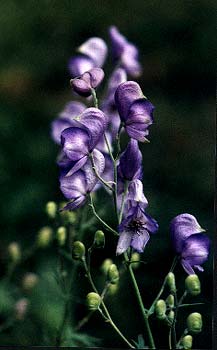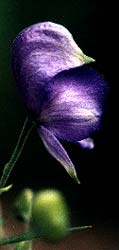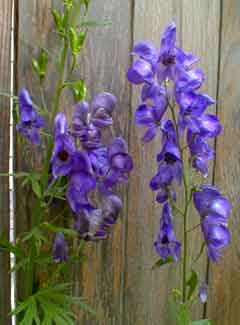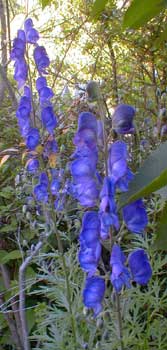
Aconitum napellus,
European Monkshood
"The wolfsbane I should dread;
Nor will I dreary rosemarye,
That always mourns the dead;
But I will woo the dainty rose,
With her cheeks of tender red."
-Thomas Hood
1799-1845
1799-1845
 The monkshood shown in the first three photos on this page was sold without a cultivar name & it may really be the wild form of Aconitum napellus. It is native of mountains of Europe, where it prefers areas near streams, or damp grasslands. In the garden it wants rich humousy soil & persistent moistness. This one is shaded by a fence & by the Alaska Cedar. It grows from three to five feet of height with deeply cut foliage & loose spikes of blue flowers, generally sturdy enough to not need staking, though occasionally one of the flower stalks is weak.
The monkshood shown in the first three photos on this page was sold without a cultivar name & it may really be the wild form of Aconitum napellus. It is native of mountains of Europe, where it prefers areas near streams, or damp grasslands. In the garden it wants rich humousy soil & persistent moistness. This one is shaded by a fence & by the Alaska Cedar. It grows from three to five feet of height with deeply cut foliage & loose spikes of blue flowers, generally sturdy enough to not need staking, though occasionally one of the flower stalks is weak.The first two photos are from August (2002), the third from late June (2004). It always blooms first in June & July, but if it is deadheaded in a timely way, before going to seed, it will have the August rebloom, though the June flowering is more certain. A named cultivar of the same species, 'Newry Blue,' also blooms in June, as does another wild clump of A napellus shown in fourth photo below, photographed in June (2004). This last grows between one of the cherry trees & a stand of evergreen huckleberries. It too is sturdy without staking; it does sometimes lean a bit, but with a cocky self-sure posture, not like it's falling over.
 At first glance monkshoods might be mistaken for a bright blue delphinium both for foliage & blossom, but on closer inspection, there are none of the spurred flowers of delphiniums, but the individual blooms on the monkshood are unquestionably shaped like footsoldiers' or knights' helmets, a shape intended to fascilitate visits from its preferred pollinators, bumblebees. A deep blue wild monkshood native to Alaska & the Northwest Canada is named A. delphiniifolia or "Delphinium-leafed" specifically because of their resemblance, which is no less the case with this & many other species of monkshood. As A. napellus tolerates more shade than do delphiniums, monkshood is a good substitute for something of a similar appearance, but more accepting of half shade. Monkshood is also much, much longer lived than delphiniums.
At first glance monkshoods might be mistaken for a bright blue delphinium both for foliage & blossom, but on closer inspection, there are none of the spurred flowers of delphiniums, but the individual blooms on the monkshood are unquestionably shaped like footsoldiers' or knights' helmets, a shape intended to fascilitate visits from its preferred pollinators, bumblebees. A deep blue wild monkshood native to Alaska & the Northwest Canada is named A. delphiniifolia or "Delphinium-leafed" specifically because of their resemblance, which is no less the case with this & many other species of monkshood. As A. napellus tolerates more shade than do delphiniums, monkshood is a good substitute for something of a similar appearance, but more accepting of half shade. Monkshood is also much, much longer lived than delphiniums.A. napellus is one of the most poisonous of this highy toxic genus. It was used throughout Europe as a wolf poison, & in India as a tiger poison, lacing meat left for the mankillers to scavenge. Several of its common names allude to this value: Wolfsbane, Leopard Bane, Tiger Bane, Dog's Bane, & occasionally, a mite absurdly, Wolf's Hat. It was even called Mousebane, due to Pliny's absurd claim that it was so potent a poison that the very odor of it would kill a mouse at a great distance.
The marvelously unique shape of the blossoms gave rise to the most common name, Monkshood, but other names alluding to its helmet-like shape have included Friar's Cap, Friar's Cowl, Helmet Flower, Soldier's Helmet, Cuckoo's Cap, Turk's Cap, or among ancient Germanic peoples, Thor's Helm, in Scandinavia Stormhatt or Oktober Stormhatt, & in Scotland, Auld Wife's Huid (Old Wife's Hood). Even in Japan, which has its native species of nearly identical appearance, it is called Hana-tori Kabuto, meaning flower-bird samurai helmet.
Still others thought it looked like a little carriage, so it was called King's Coach, Chariot of Venus, or Cupid's Car. The latter two names may have alluded to monkshood as an ingredient in witches' most sought-after product, love potions, though the outcome of using such a filtre is perhaps reflected in another folk-name, Mourning Bride, with the hood in that case seen as a widow's veil. Its association with sorcery lent it yet another baleful name, Witch's Bane. In late medieval times it was thought to be a key ingredient in a potion that permitted witches to fly. But of all its wonderful names, Monkshood, Wolfsbane, or Aconite are most used today.
 In mythology, Monkshood was nefarious Medea's poison of choice. Ovid said she gathered it in Scythia, where it first grew from the slobber of three-headed Cerberus, the terrible dog that guards the gate to Tartarus. Pliny also tells the story of Hercules dragging the monstrous beast through its cavern to chain it to a pillar, & from its howling snapping jaws slavering froth flung out of cave giving rise to this plant in the mortal world. So when called "Dogbane," Cerberus the offspring of the Echidna is the dog meant, while the name "Aconite" alludes to Aconitus in Pontica on which hillside Cereberus's cavern was to be found.
In mythology, Monkshood was nefarious Medea's poison of choice. Ovid said she gathered it in Scythia, where it first grew from the slobber of three-headed Cerberus, the terrible dog that guards the gate to Tartarus. Pliny also tells the story of Hercules dragging the monstrous beast through its cavern to chain it to a pillar, & from its howling snapping jaws slavering froth flung out of cave giving rise to this plant in the mortal world. So when called "Dogbane," Cerberus the offspring of the Echidna is the dog meant, while the name "Aconite" alludes to Aconitus in Pontica on which hillside Cereberus's cavern was to be found.The plant was sacred to Hecate, hence its archaic name Hecateis herba, the Dark-mother's Herb, which is probably also at the base of its title Queen Mother (or Queenmother of Poisons), as Hecate was by medieval times Queen of Witches. Athena used the poison as well, sprinkling it on the head of the impious maiden weaver Arachne to turn her into a spider.
Claudius I, Emperor of Rome, was slain by his own physician who slipped him monkshood. It was so often used for political assassinations that Trajon banned its cultivation altogether. Anyone caught gardening these flowers risked a penalty of death.
It's use for murder is the subject of the Peter Ellis novel set in medieval England, Monk's Hood (1981). Brother Cadfael the detective-monk must clear himself of suspicion. The plant is featured in many other fictional murder mysteries, but not all such crimes are fictive. In a series of recent trials infamous in Japan, three women & one man were proven to have collectied millions of yen in their murder-for-insurance ring, the women having prepared for their husbands sweet-bean buns laced with monkshood. The trials ended in 2002, & all four received long prison terms.
It was also useful for suicide, as in the case of the father of Leopold Bloom in James Joyce's Ulysses, as well as endless numbers of actual persons. But not all deaths have been intentional homicides or suicides, for Monkshood is sometimes mistaken for fennel or horseradish or other edible plant, as even the species name napellus or "Little Turnip" alludes to its resemblance to something edible. Somewhere around 1840, two Catholic priests arrived to dinner with other guests of the Provost of Dingwall. A servant obtained a radish from the garden for the guests to use as garnish on their meat, in consequence of which three at the table died, including Father Angus Mackenzie, Father James Gordon, & Father Gordon's grand-nephew.
A final tale belongs here since the species attached to this legend is certainly A. napellus & no other. Monkshood has another old folk-name, St. Dunstan's Herb, & in portraits of St. Dunstan, tenth century Archbishop of Canterbury, monkshood is often present. Dunstan was said once to have held the devil by the nose with a pair of red-hot tongs, forcing from him an oath to never again tempt the saint. Shortly thereafter Dunstan dreamt of an enormous branching spire of flowers shaped like the cowls of monks, & interpretted this as indicative of Christianity spreading throughout a future England ruled by Catholic clergy. A most curious legend for Catholics to tell of themselves. I'm sure Oliver Cromwell would've agreed Catholicism was a poisonous plant.
Aconitum charmichaeli, Chinese Azure Monkshood